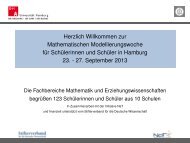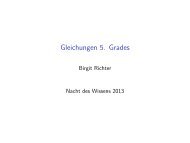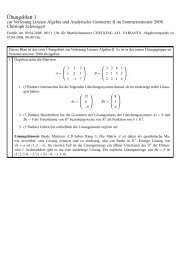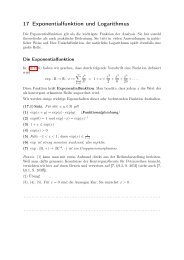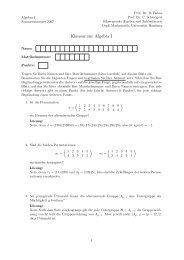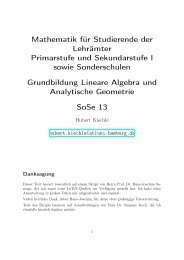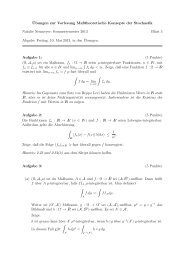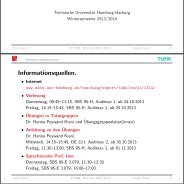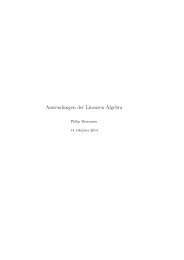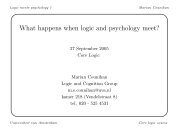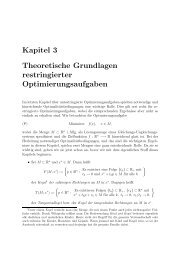pdf file
pdf file
pdf file
Create successful ePaper yourself
Turn your PDF publications into a flip-book with our unique Google optimized e-Paper software.
This shows that the vectors (b i ) i=1,...N are a generating system for V and thus that V is<br />
finite-dimensional. The converse is obvious.<br />
✷<br />
Corollary 4.1.10.<br />
Let Z be a topological field theory of dimension n. Then for every closed (n − 1)-manifold M,<br />
the vector space Z(M) is finite-dimensional, and the pairing Z(M) ⊗ Z(M) → K is perfect:<br />
that is, it induces an isomorphism α from Z(M) to the dual space of Z(M).<br />
In low dimensions, it is possible to describe topological field theories very explicitly.<br />
Example 4.1.11 (Topological field theories in dimension 1).<br />
• Let Z be a 1-dimensional topological field theory. Then Z assigns a finite-dimensional<br />
vector space Z(M) to every closed oriented 0-manifold M, i.e. to a finite set of oriented<br />
points. Since the functor Z is monoidal, it suffices to know its values Z(•, +) and Z(•, −)<br />
on the positively and negatively oriented point which are finite-dimensional vector spaces<br />
dual to each other. Thus<br />
Z(M) ∼ = ( ⊗<br />
V ) ⊗ ( ⊗<br />
V ∨ )<br />
x∈M + y∈M −<br />
with V := Z(•, +).<br />
• To fully determine Z, we must also specify Z on 1-manifolds B with boundary. Since Z<br />
is a symmetric monoidal functor, it suffices to specify Z(B) when B is connected. In this<br />
case, the 1-manifold B is diffeomorphic either to a closed interval [0, 1] or to a circle S 1 .<br />
• There are five cases to consider, depending on how we interpret the one-dimensional<br />
manifold B with boundary as cobordism:<br />
(a) Suppose that B = [0, 1], regarded as a bordism from (•, +) to itself. Then Z(B)<br />
coincides with the identity map id V : V → V .<br />
(b) Suppose that B = [0, 1], regarded as a bordism from (•, −) to itself. Then Z(B)<br />
coincides with the identity map id : V ∨ → V ∨ .<br />
(c) Suppose that B = [0, 1], regarded as a bordism from (•, +) ∐ (•, −) to the empty<br />
set. Then Z(B) is a linear map from V ⊗ V ∨ into the ground field K: the evaluation<br />
map (v, λ) ↦→ λ(v). Since the order matters, we also consider the related bordism<br />
from (•, −) ∐ (•, +) to the empty set. Then Z(B) is a linear map from V ∨ ⊗ V into<br />
the ground field K: the evaluation map (λ, v) ↦→ λ(v).<br />
(d) Suppose that B = [0, 1], regarded as a bordism from the empty set to (•, +) ∐ (•, −).<br />
Then Z(B) is a linear map from K to Z((•, +) ∐ (•, −)) ∼ = V ⊗ V ∨ . Under the<br />
canonical isomorphism V ⊗V ∨ ∼ = End(V ), this linear map is given by the coevalution<br />
x ↦→ xid V . Again, we can exchange the order of the objects.<br />
(e) Suppose that B = S 1 , regarded as a bordism from the empty set to itself. Then<br />
Z(B) is a linear map from K to itself, which we can identify with an element of K.<br />
To compute this element, decompose the circle S 1 ∼ = {z ∈ C : |z| = 1} into two<br />
intervals<br />
S 1 − = {z ∈ C : (|z| = 1) ∧ Im (z) ≤ 0} S 1 + = {z ∈ C : (|z| = 1) ∧ Im (z) ≥ 0},<br />
with intersection<br />
S 1 − ∩ S 1 + = {±1} ⊆ S 1 .<br />
87




